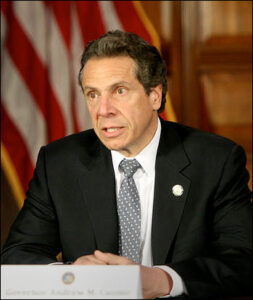By Jim Ellis
March 30, 2022 — Resigned New York Gov. Andrew Cuomo (D) has rather astonishingly not yet ruled out trying to regain his position in this election, and a new Siena College Research Institute poll (March 20-24; 804 registered New York voters, 309 Democratic primary voters) suggests that he might be a competitive contender should he ultimately enter the race.While it is still unlikely that Cuomo will return, although he has already financed a wave of “rehabilitation” ads designed to improve his damaged image, the Siena numbers do reveal some weaknesses within the Democratic establishment. This means the general election might become interesting.
One of the Siena poll questions asked about Cuomo’s potential status as an independent candidate for the November election. With an eventual Republican nominee, likely US Rep. Lee Zeldin (R-Shirley/East Long Island), presumably being more competitive than a typical New York statewide GOP candidate in this coming general election, a strong independent or minor party contender could become a significant factor in the final outcome and may even have a narrow victory path.
If the resigned governor is to make a move, he is running out of time to file in a partisan primary. Since he is not the endorsed New York Democratic Party candidate, Gov. Kathy Hochul is, he could obtain a ballot position only through submitting 15,000 valid registered voter signatures on or before the April 7 candidate filing deadline. If he were to attempt ballot access as an Independent, that related deadline does not expire until May 31.
While the base Democratic numbers are still strong for President Biden and Gov. Hochul, base Republicans are equivalently fervent against them, but this group is less than half the former’s size. More problematic for the Democratic incumbents and candidates, however, are the non-affiliated voter results, which are clearly trending away.
According to the Siena figures, Gov. Hochul already has an upside-down job approval rating of 42:53 percent within the electorate as a whole, but a positive 63:33 percent ratio among Democrats. She records only a 19:65 percent favorably index from Republicans and a more troubling 31:40 percent negative ratio with the non-affiliated and minor party voter segment.
The most recent published voter registration figures, those dated Feb. 21, 2022 from the New York State Board of Elections, find that 12,982,819 individuals are registered to vote, 49.8 percent of who identify as Democrats. Republicans account for only 21.9 percent of the overall electorate, and added with the 1.2 percent who register in the Conservative party, the clear right-of-center percentage expands to 23.1 percent. Still, this combined figure is less than half of the Democratic number.




